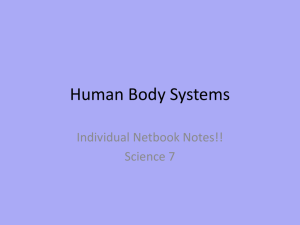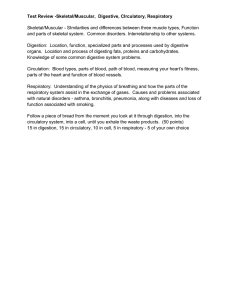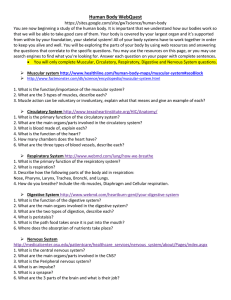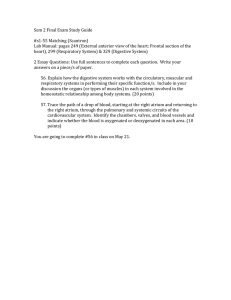Chapter 6 The Human Body 6-1
advertisement
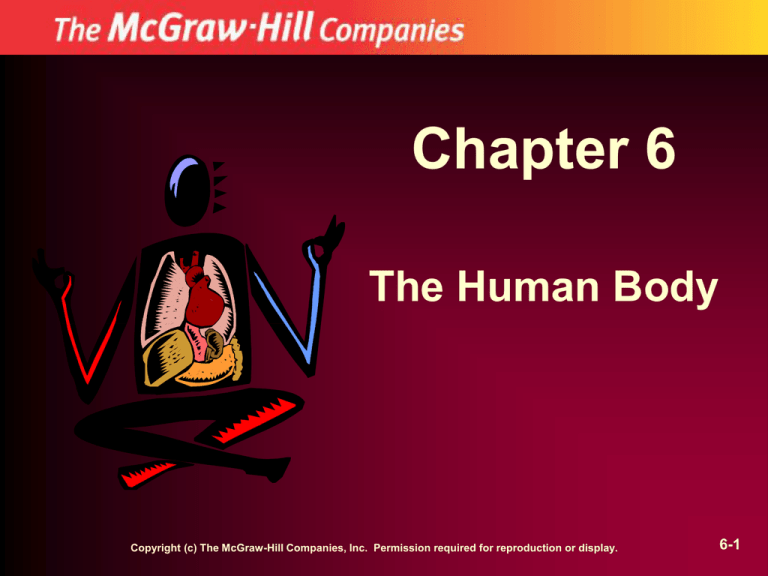
Chapter 6 The Human Body Copyright (c) The McGraw-Hill Companies, Inc. Permission required for reproduction or display. 6-1 Objectives 6-2 Introduction • Anatomy – The study of the structure of an organism, such as the human body • Physiology – The study of the normal functions of an organism, such as the human body 6-3 Structural Organization 6-4 Cell Function 6-5 Body Organization • Cells • Tissues • Organs – Vital organs • Organ systems 6-6 10 Major Organ Systems 1. 2. 3. 4. 5. Circulatory Digestive Endocrine Integumentary Muscular 6. Nervous 7. Reproductive 8. Respiratory 9. Skeletal 10.Urinary 6-7 Homeostasis • Organ systems work together to maintain a constant internal environment (homeostasis). • Cell metabolism – Aerobic metabolism – Anaerobic metabolism 6-8 Homeostasis • Body fluids – Two main compartments – Intracellular fluid (ICF) • Fluid within the walls of body cells • Accounts for about two-thirds of body water – Extracellular fluid (ECF) • Fluid within the blood vessels • Fluid within the tissues 6-9 Body Cavities 6-10 Abdominal Quadrants 6-11 Body Planes 6-12 Musculoskeletal System 6-13 Musculoskeletal System • Gives the body its shape • Allows the body to move • Protects major organs of the body 6-14 Skeletal System • Consists of 206 bones of varying types • Bones – Store minerals – Many bones contain bone marrow. • Bone marrow produces blood cells. 6-15 Skeletal System 6-16 Skeletal System 6-17 • Bones are classified by shape and size. 6-18 Bones of the Skull 6-19 Vertebral (Spinal) Column 6-20 Vertebral Discs 6-21 Spinal Cord and Spinal Nerves 6-22 The Chest (Thorax) 6-23 Upper Extremity 6-24 Lower Extremity 6-25 The Muscular System • Gives the body shape • Protects internal organs • Provides for movement of the body • Maintains posture • Helps stabilize joints • Produces body heat 6-26 The Muscular System • Muscles are classified according to their structure and function. – Skeletal (voluntary) muscle – Smooth (involuntary) muscle – Cardiac muscle 6-27 • Skeletal muscles and bones work together as levers. 6-28 Smooth Muscle • Involuntary • Strong, slow contractions • Found in – Walls of GI tract and urinary system – Blood vessels – Eye – Bronchi 6-29 Cardiac Muscle • Found only in the heart • Produces heart’s contraction and pumps blood • Has its own blood supply through the coronary arteries • Normal contractions are strong and rhythmic. • Involuntary 6-30 Comparison of Muscle Types Skeletal Smooth Location Attached to bone by tendons Function Moves the Moves food through skeleton the digestive Produces heat that tract helps maintain Adjusts the size of a constant blood vessels to body control blood temperature flow Maintains posture Contracts and relaxes the heart Moves blood through the body Voluntary Involuntary Type of Control Walls of the esophagus, stomach, intestines, bronchi, uterus, blood vessels, glands Cardiac Involuntary Walls of the heart 6-31 Respiratory System 6-32 Respiratory System 6-33 Respiratory System 6-34 Swallowing 6-35 Respiratory System 6-36 Respiratory System 6-37 Respiratory System 6-38 Ventilation • Breathing (pulmonary ventilation) – Process of moving air into and out of the lungs • Inspiration (inhalation) – Process of breathing in and moving air into the lungs • Expiration (exhalation) – Process of breathing out and moving air out of the lungs 6-39 Respiratory System • Respiration • Tidal volume • Anatomic dead space • Minute volume 6-40 Mechanics of Breathing • Chemoreceptors – Central • Medulla oblongata in the brain • Monitor carbon dioxide level – Peripheral • Carotid arteries • Arch of the aorta • Monitor oxygen and carbon dioxide levels 6-41 Mechanics of Breathing 6-42 Structures that Support Ventilation • Chest wall • Pleurae • Diaphragm • Intercostal muscles • Phrenic nerves • Pulmonary capillaries 6-43 Respiration • Respiration – Exchange of gases between a living organism and its environment • Internal respiration • External respiration 6-44 Respiration • Alveolar/capillary gas exchange • Cell/capillary gas exchange 6-45 Circulatory System 6-46 Circulatory System • Cardiovascular system – Pump (heart) – Fluid (blood) – Container (blood vessels) • Lymphatic system – Lymph – Lymph nodes – Lymph vessels – Tonsils – Spleen – Thymus gland 6-47 Circulatory System • Functions – Delivers oxygen-rich blood and nutrients to body tissues – Helps maintain body temperature – Protects the body against infection – Controls bleeding – Removes waste and by-products of metabolism from body tissues – Transports hormones and other chemical messengers to targeted tissues of the body 6-48 The Heart 6-49 Blood Flow through the Heart 6-50 Blood Flow through the Heart 6-51 Blood • Transport system • Works with lymphatic system to protect the body against infection 6-52 Blood Components 6-53 Blood Vessels Arteries → arterioles → capillaries → venules → veins 6-54 Veins Contain One-Way Valves 6-55 Major Arteries 6-56 Major Veins 6-57 Physiology of Circulation • Pulse – Central – Peripheral • Blood pressure – Systolic – Diastolic 6-58 Nervous System 6-59 Nervous System 6-60 • The brain is housed in the cranium. 6-61 Areas of the Brain 6-62 Spinal Cord • Relays electrical signals to and from the brain and peripheral nerves 6-63 Peripheral Nervous System (PNS) 6-64 Autonomic Nervous System • Sympathetic division – Mobilizes energy, particularly in stressful situations – “Fight-or- flight” response – Effects are widespread throughout the body • Parasympathetic division – Conserves and restores energy – Effects are localized in the body 6-65 Integumentary System 6-66 Integumentary System 6-67 Digestive System 6-68 Digestive System • Functions – Ingestion – Digestion – Absorption – Defecation 6-69 Digestive System Components 6-70 Digestive System • Peristalsis • Process of digestion 6-71 Endocrine System 6-72 Endocrine System • Functions – Secretes chemicals (hormones) directly into the circulatory system – Influences body activities and functions – Works closely with nervous system to maintain homeostasis 6-73 Endocrine System Components 6-74 Reproductive System 6-75 Reproductive System • Function – Makes cells (sperm, eggs) that allow continuation of the human species 6-76 Male Reproductive System 6-77 Female Reproductive System 6-78 Urinary System 6-79 Urinary System • Functions – Removes body wastes – Assists in regulating blood pressure – Helps control the amount and composition of water and other substances in the body 6-80 Urinary System • Components – Kidneys – Ureters – Bladder – Urethra 6-81 Questions? 6-82
